Fires In History: The Peshtigo Fire of 1871
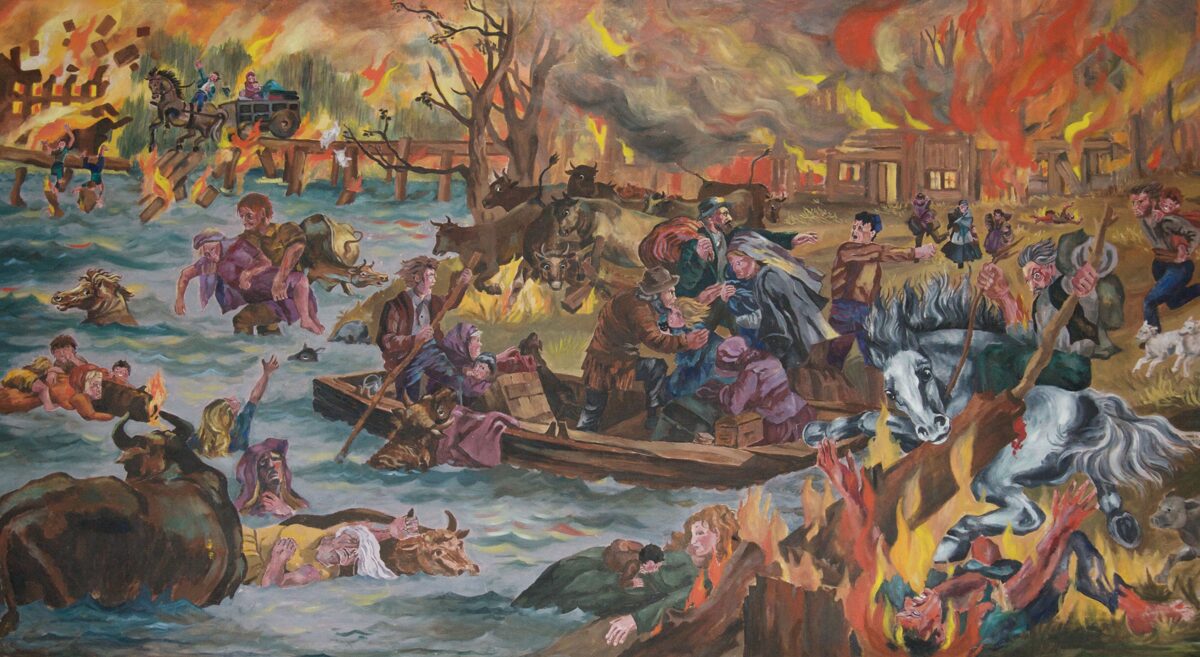
We will start with a question:
What comes to mind when you think of devastating fires in American history?
For many, the Great Chicago Fire of 1871 might immediately spring to mind—the inferno that left a bustling city in ruins. Yet, lurking in the shadow of this well-known tragedy lies a forgotten tale of horror and devastation, one that eclipses the Chicago fire in its scale of destruction and loss of life. In the annals of American history, the Great Chicago Fire of 1871 often steals the limelight, leaving a lesser-known tragedy lurking in the shadows. On that fateful night of October 8, 1871, as Chicago burned, the Peshtigo wildfire raged through Wisconsin, turning the town and its surroundings into an inferno of unprecedented proportions. Despite its devastating impact and historical significance, the Peshtigo wildfire has faded from national memory. Today, we delve into this forgotten chapter of history, exploring the reasons behind its obscurity and uncovering the shocking statistics that make it the deadliest wildfire in American history.
The Rise and Fall of Peshtigo
The story begins in Peshtigo, a bustling logging town nestled amidst dense forests and perched on the shores of Lake Michigan. This prime location made it a hub for the booming logging industry, attracting immigrants from across Europe. Peshtigo's proximity to Chicago, the largest lumber trade market of its time, fueled its growth as it supplied timber for the rapidly expanding nation.
However, Peshtigo's prosperity would ultimately seal its tragic fate.
The Perfect Storm
The series of events leading to the catastrophic blaze began with an eerie "rumbling noise" that gradually intensified, reminiscent of an approaching train. Panic ensued as the town was engulfed in flames. Witnesses describe a cyclone-like firestorm, a relentless whirlwind consuming everything in its path. It was a nightmarish scenario where buildings ignited in quick succession, leaving little time for escape.
As survivors reached the river, they watched in despair as their entire town succumbed to the flames. Cows and horses joined the frantic exodus, adding to the chaos. Some who sought refuge in the river tragically drowned or succumbed to hypothermia.
The morning light revealed a desolate, unrecognizable landscape devoid of human habitation. The aftermath was a grim tableau of suffering and despair.
The Fiery Culprit
The summer of 1871 had been one of the driest on record, setting the stage for disaster. A 20th-century reconstruction by the National Weather Service traced the calamity to a prolonged period of high temperatures and drought, culminating in a low-pressure front with cooler temperatures and winds that whipped smaller fires into a colossal conflagration. With winds reaching a staggering 100 miles per hour, the flames roared uncontrollably, fueled by a vicious cycle of air currents.
Man-made Blunders
The logging industry in Peshtigo played a significant role in the catastrophe. Before responsible forest management practices existed, loggers stripped the land recklessly, creating fire hazards with discarded wood and refuse. Railroad operations added to the peril by clearing land with small fires, leaving behind piles of combustible wood.
The town itself was a tinderbox, with most structures, sidewalks, and even streets constructed from wood or wood chips. The conditions were ripe for disaster, and the spark that ignited this volatile situation was the severe weather on that ill-fated night.
Overlooked Tragedy
While the Peshtigo fire claimed between 500 and 800 lives, leaving half of the town's population in ashes, the disaster's true scale extended to northeastern Wisconsin and Upper Michigan, where between 1,200 and 2,400 people perished. Regrettably, records of many communities ravaged by the fire were also lost, making it impossible to account for all victims.
What added to the obscurity of the Peshtigo wildfire was the simultaneous occurrence of the Great Chicago Fire. While the Chicago fire left 100,000 people homeless and destroyed thousands of structures, it garnered more attention due to its urban setting. Consequently, the Peshtigo fire was relegated to the background of history.
A Lesson in Remembering
Yet, the Peshtigo wildfire's legacy endures in the realms of forest management and firefighting. It serves as a stark reminder of the consequences of poor forestry practices and the unpredictable power of wildfires. Moreover, the residents of Peshtigo themselves have not forgotten; they rebuilt their town and laid to rest the remains of over 300 victims in a mass grave, a poignant tribute to their enduring memory.
In conclusion, the Peshtigo wildfire, despite its staggering statistics and historical significance, has remained overshadowed by the Great Chicago Fire. However, it is a lesson etched in history, serving as a cautionary tale of the devastation that can result from neglecting responsible land management practices. As we reflect on this forgotten fury, we honor the resilience of Peshtigo's people and the enduring importance of understanding our history to shape a safer future.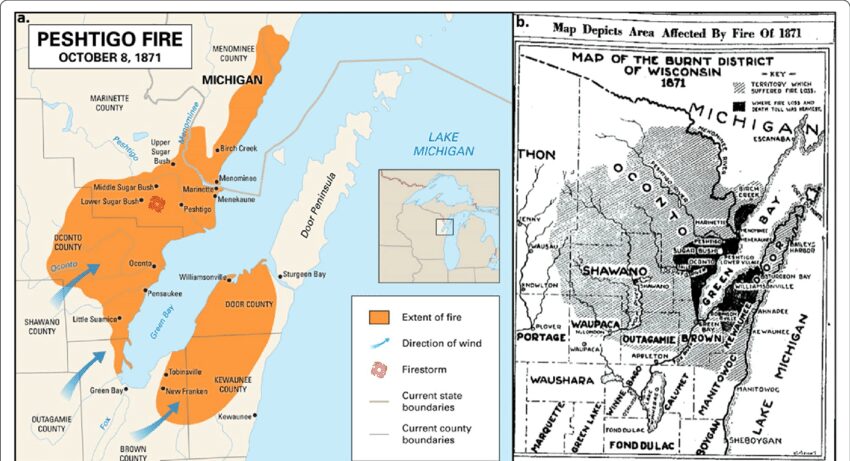
map of Peshtigo wildfire of 1871
_______________________________________________________________________
What's AMPLICAM?
AMPLICAM is a technology company focused on early wildfire detection. We use cutting-edge AI/ML and computer vision solutions to reduce the risk of climate change on a global scale.
Surviving Wildfires: Tips for Travelers and Residents
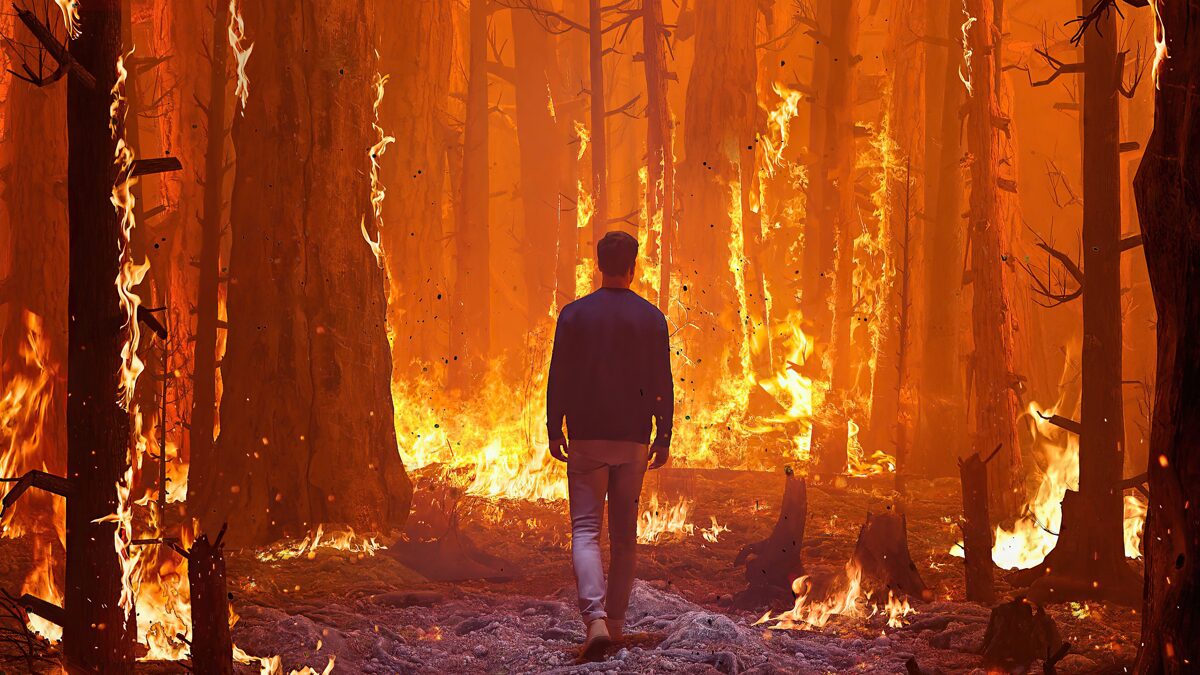
The recent devastating wildfires in Hawaii serve as a grim reminder of the destructive power of these natural disasters. For those residing in wildfire-prone areas, staying informed and prepared is paramount. But what about travellers who might be less familiar with the risks?
Here are some essential tips to increase your chances of survival or avoid being caught in a wildfire:
1. Stay Informed: Whether you're a resident or a traveller, stay aware of wildfire news and weather conditions. Pay attention to local news, especially if you're in a wild land area, as fires can quickly change direction.
2. Red Flag Warnings: Heed red flag warnings—these are weather alerts indicating high fire danger due to factors like extreme heat and strong winds. Avoid travelling to areas with red flag warnings in effect.
3. Leave Early: Consider leaving an area even before an official evacuation notice is issued if you sense a wildfire threat.
4. Get Alerts: Sign up for wildfire alerts on platforms like readyforwildfire.org and listen to local talk radio and news stations when travelling. AirNow and EFFIS are useful for tracking wildfires in North America and Europe, respectively. MyFireWatch can provide tracking information in Australia.
5. Have an Escape Plan: If you're in a wildfire-prone area, develop an escape plan and identify alternative escape routes. Don't solely rely on digital maps; keep a physical map in case of service interruptions.
6. Prepare a Survival Kit: Keep essentials like water, food, clothes, and a battery-powered radio in your vehicle. An N-95 mask is crucial for protecting against smoke.
7. Report Smoke or Fire: If you see smoke or fire, report it immediately to local authorities.
8. Be Prepared Year-Round: Wildfires are no longer limited to specific seasons or regions. Be vigilant year-round, as wildfires can occur in unexpected places and at any time.
Now, let's delve deeper into surviving wildfires when you find yourself in a vehicle.
When wildfires encroach upon your location, finding yourself in a vehicle can be both a blessing and a potential hazard. Here are some essential steps to maximise your chances of survival:
1. Stay Inside: First and foremost, stay inside your vehicle. Contrary to what you might think, vehicles provide a fair amount of protection from wildfires. The metal shell acts as a barrier against flames, radiant heat, and embers.
2. Seal Windows and Vents: Immediately close all windows and vents. This helps prevent smoke and embers from entering the vehicle's interior. Even small openings can allow dangerous smoke to infiltrate.
3. Cover Yourself: If you have a jacket or blanket, use it to cover yourself. This extra layer can provide additional protection from heat and smoke.
4. Lie Low: If possible, lie on the vehicle's floor. Heat rises, so the floor is generally cooler and less filled with smoke. Make sure to keep your head as low as possible to avoid inhaling harmful fumes.
5. Attempt to Drive Away: If you can see clearly and safely, attempt to drive away from the fire. Follow your escape plan if you have one, but remember that visibility can deteriorate rapidly in thick smoke, so stay cautious.
Remember, while a vehicle can offer relative safety during a wildfire, there are no guarantees. If the situation worsens to the point where the flames surround the vehicle, it's vital to have a backup plan. In such a case, staying inside the vehicle is still your best bet for protection. By following these guidelines, you can significantly increase your chances of surviving a wildfire while in a vehicle.
So far, we discussed crucial tips for staying safe during wildfires, including staying informed, preparing an escape plan, and surviving in a vehicle. Now, let's get into how to maximise your chances of survival when you're inside a structure, outdoors and what to watch out for after a wildfire has passed through.
Surviving in a Structure
1. Stay Inside: Just like with a vehicle, staying inside a structure is usually safer than being outside. Keep doors and windows closed to prevent the intrusion of smoke and embers.
2. Block Openings: Use wet towels or cloths to block openings around doors and windows. This helps keep smoke and embers out of the building.
3. Prepare Fire Extinguishers: Have fire extinguishers readily available, and know how to use them. This can be vital if small fires ignite inside your shelter.
4. Water Resources: Fill sinks, bathtubs, and buckets with water. This water can be used to extinguish small fires, hydrate, and dampen towels for sealing openings.
If the structure catches fire, your safety may depend on quickly evacuating. Make sure you have a clear exit plan and are ready to leave if necessary.
Trapped Outdoors
1. Call for Help: Dial 911 and provide your exact location. Rescuers may be able to reach you via helicopter or deploy firefighters to protect you.
2. Move Downhill: Whenever possible, move downhill, away from the fire's path. Avoid gullies or ravines, as it can be challenging to escape uphill.
3. Seek Water: If you're near a body of water like a lake or river, try to reach it. Some people have successfully waited out wildfires by staying in the water.
4. Stay Away from Low-Lying Areas: Avoid low-lying areas like gulches or ditches filled with dry vegetation, as these can act as fire funnels and trap you.
5. Find Safe Zones: Identify areas that are less likely to burn, such as irrigated fields, golf courses, paved parking lots, and ponds. Seek shelter behind boulders and rock outcrops if available.
Post-Fire Dangers
1. Hot Ash and Embers: Be cautious of hot ash, smouldering debris, and live embers, even after the fire appears to be out.
2. Downed Power Lines: Stay clear of damaged or fallen power lines, poles, and downed wires, as they can still pose electrical hazards.
3. Ash-Filled Pits: Watch for pits in the ground filled with ash. These may contain hidden hot embers that can cause burns.
By following these guidelines, you can better prepare yourself to handle various situations when facing a wildfire. Remember that preparation, awareness, and quick thinking are your allies in ensuring your safety during these challenging events.
_________________________________________________________________________________
What's Amplicam? - Amplicam is a technology company focused on early wildfire detection. We use cutting-edge AI/ML and computer vision solutions to reduce the risk of climate change on a global scale. www.amplicam.com #WildfireSafety #wildfires #wildfireprevention #EmergencyPreparedness #StayInformed #SurvivalTips
Amplicam participate in 8th International Wildland Fire conference in Porto

Amplicam attended the Wildland Fire conference in Porto, Portugal from 15/05 till 19/05/2023. The main objective of the 8th IWFC was to create space for presentation of current results of work in the field of wild-land fire. The conference was also a space for creating collaborative links between professionals, academics, industry and public authorities aiming at long-term sharing of knowledge and discussions of highly current issues.
Main themes included:
● Planning and Preparation
Defining interventions and resources needed at the
community and government levels, as well as ensuring that citizens and
organisations are prepared to act under best safety practices.
● Prevention and
Pre-Suppression
Reducing exposure and vulnerability to fire and
maintaining a state of preparedness for immediate intervention.
● Suppression and Relief
Suppressing fire and providing relief to those
affected by fire.
● Post-fire Intervention
Dealing with the restoration and rehabilitation
actions required in the aftermath of a fire.
● Qualification
Training and certification on all integrated fire
management expertise areas.
● Technical Innovation
Innovation on software applications and
technological equipment and solutions, and operational communications systems.
● Risk Handling
Dealing with risk perception, assessment,
management and transnational research, encompassing traditional and indigenous
knowledge.
● Stakeholder Engagement
Inclusive risk-related decision-making and conflict
resolution, regarding multi-level policy design, sustainability, and funding.
● Adaptive Management
Process Monitoring and Planning Evaluation for
continuous improvement and lessons learnt and analysis of physical and social
impacts due to changes in fire governance.
● Communication
Risk Communication – exchanging or sharing
risk-related data, information and knowledge between and among different groups
such as scientists, regulators, industry and general public; Public report of
system performance.
● International Cooperation
Cross-border cooperation on training,
best-practices, and standards.
As a result of this conference to better prepare societies to achieve sustainable development goals and ensure lower losses in fires, the technical and scientific community at the 8th International Wildland Fire Conference in Porto, proposed a fire governance model (Landscape Fire Governance Framework) that brings governments, businesses, academia, and members of civil society together in balanced and technically supported solutions.
This framework presents the guidelines for the development of this model.
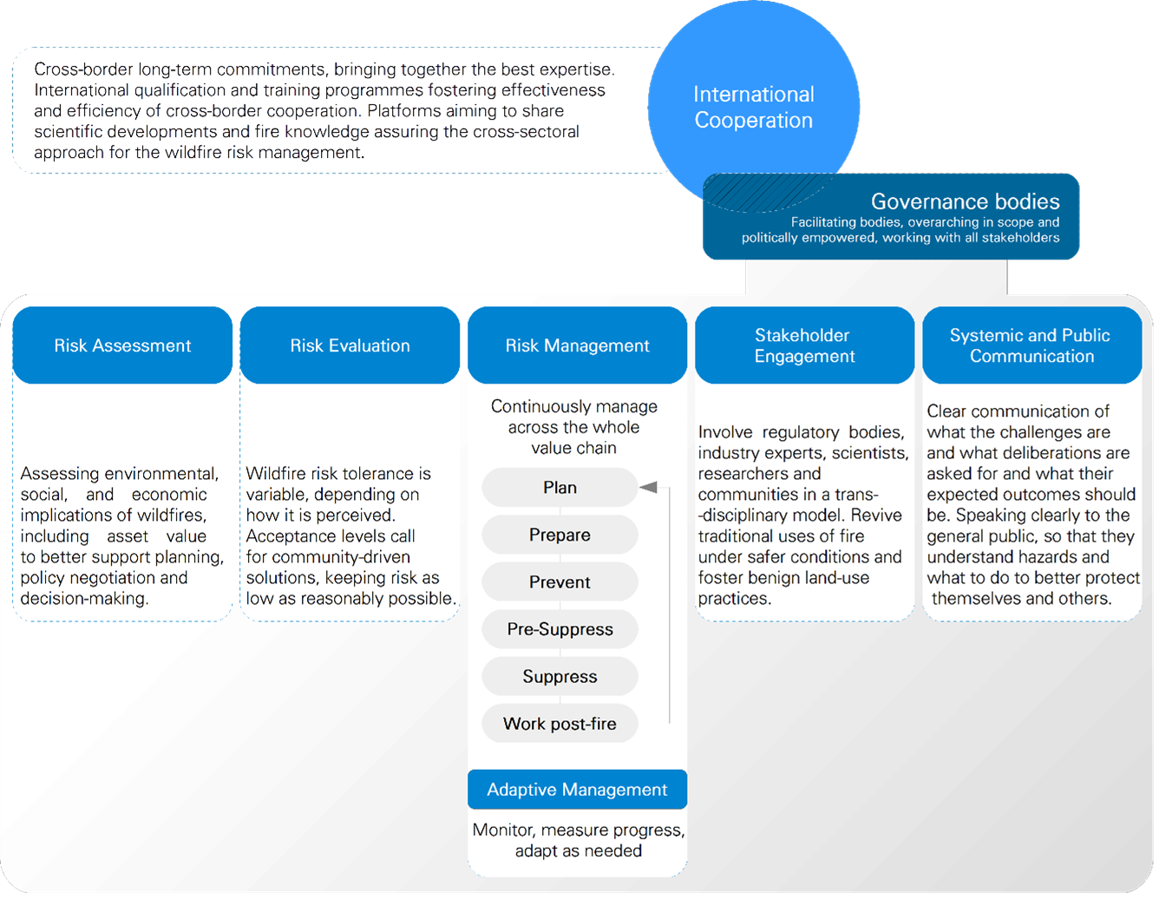
Sources:
Amplicam supports Wildfire Technology Management Summit 2023
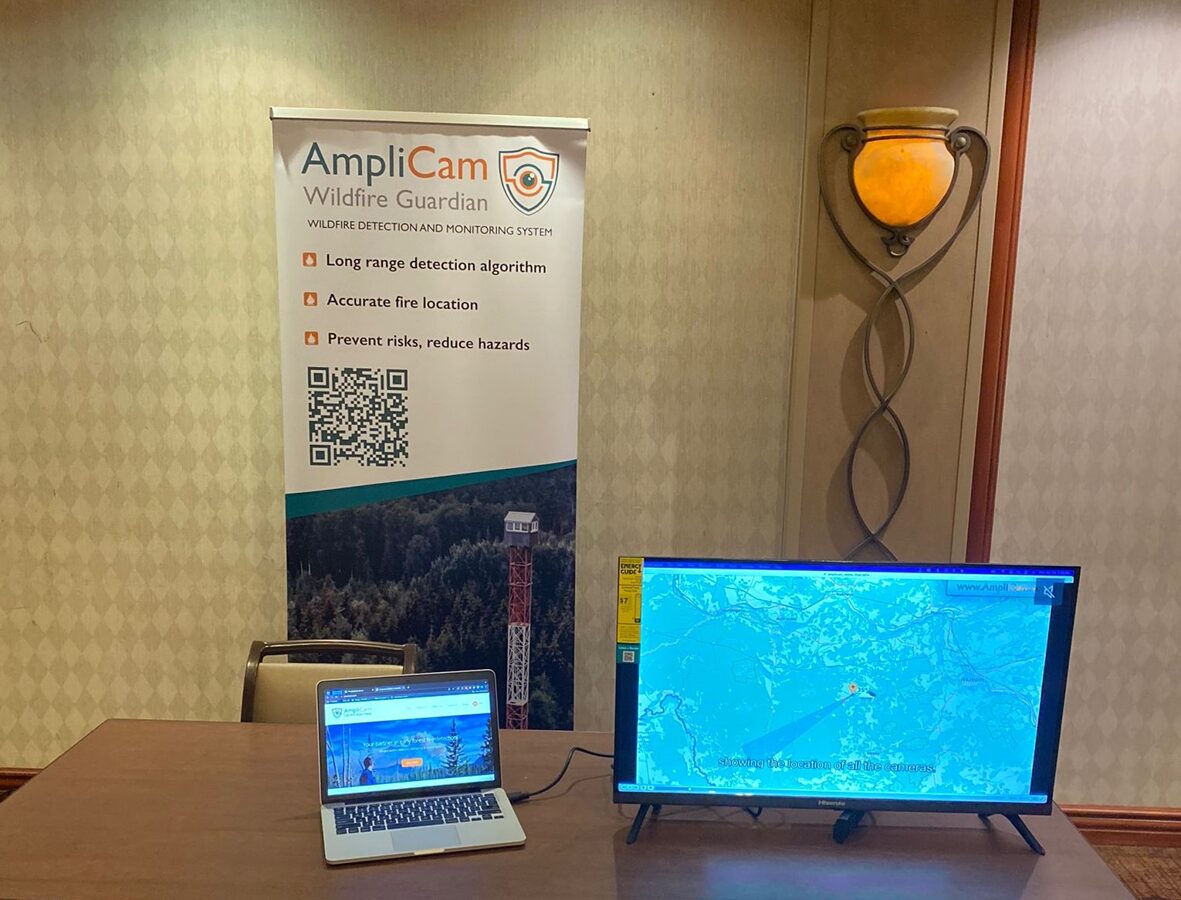
Amplicam, a leading provider of early wildfire detection and monitoring
systems, recently had the opportunity to participate in Sacramento's highly
anticipated Wildfire Technology Management Summit 2023 #WTMS2023, held in
April. The event drew a multitude of professionals from the industry, creating
a vibrant atmosphere buzzing with knowledge and innovation. Over the course of
two days, Amplicam had the pleasure of connecting with numerous individuals,
exchanging ideas and forging valuable connections.
Among the notable encounters, we were delighted to meet and engage with
passionate experts, such as @Kim Zagaris, @Tonya Hoover, @Ben McGrane, @David
Green, @Brian Fennessy, Brian Marshall, Jeff Meston, @Kim Connors, Jerome
Perez, and many more, who share our commitment to addressing the pressing issue
of wildfires. Their deep understanding and firsthand experiences reinforced the
significance of our mission and fuelled our determination to make a positive
impact. It was truly inspiring to witness the collective enthusiasm and
collaborative spirit that permeated the conference.
At Amplicam, we recognize the urgency and global scale of the wildfire problem,
particularly evident in the United States where approximately 70,000 wildfires
occur each year. California, in particular, has been no stranger to the
devastating consequences of these natural disasters, making the need for
effective solutions all the more pressing.
The Amplicam Wildfire Guardian, a cutting-edge system designed to detect fires
at the preheat stage, leveraging commercially available cameras and advanced
analytics software. Early detection is paramount in minimizing the damage,
losses, pollution, and resources consumed by wildfires. By identifying fires in
their incipient stages, we can swiftly mobilize resources, coordinate
responses, and mitigate the impact of these destructive forces.
Our innovative solution is built upon a network of existing video surveillance
cameras, harnessing their inherent capabilities with the aid of proprietary
software. This comprehensive system provides centralized coordination,
efficient resource management, and robust report generation. Additionally, our
Geographic Information System (GIS) visually represents the precise locations
of cameras and identifies potential hazards, offering invaluable insights for
prompt action.
Participating in the Sacramento wildfire conference has reaffirmed our belief
in the power of collaboration and knowledge-sharing. Engaging with industry
professionals has not only expanded our network but has also deepened our
understanding of the challenges and opportunities in the field. We are excited
about the prospects of serving the US market in the years to come, as our
presence in North America grows stronger with offices established in both the
United States and Canada.
As we reflect on our experience at the conference, we remain committed to
pioneering innovative solutions that combat the devastating effects of
wildfires. With the Amplicam Wildfire Guardian at the forefront of our efforts,
we are determined to make a significant difference in protecting lives,
properties, and the environment. By leveraging technology and collaborative
partnerships, we can foster a future where the destructive power of wildfires
is mitigated, enabling communities to thrive in harmony with nature.
We’re looking forward to see everyone next year at the Wildfire Technology
Management Summit 2024!
Also, BIG thanks to IDGA team that organised this event, especially @Richard
Brooks, @Harriet Turner and @Sara Weissman
@Western Fire Chiefs Association
@California Governor's Office of Emergency Services
@IDGA
@ California Department of Forestry and Fire Protection (CAL FIRE)
@California Fire Chiefs Association
@U.S. Forest Service
@USDA Forest Service
@National Wildfire Suppression Association
@Valley Center Fire Protection District
#wildfire #WTMS2023 #bcwildfire, #calfire, #wildfires, #wildfireprevention, #wildfiresafety #IDGA #wildfire #technology #management #event #summit #prevent #detect #suppress #mitigate #firefighters #publicsafety #partnership #wildfire #AI #firedetection
Asbestos release during wildfires could pose an unexpected and significant threat to human health
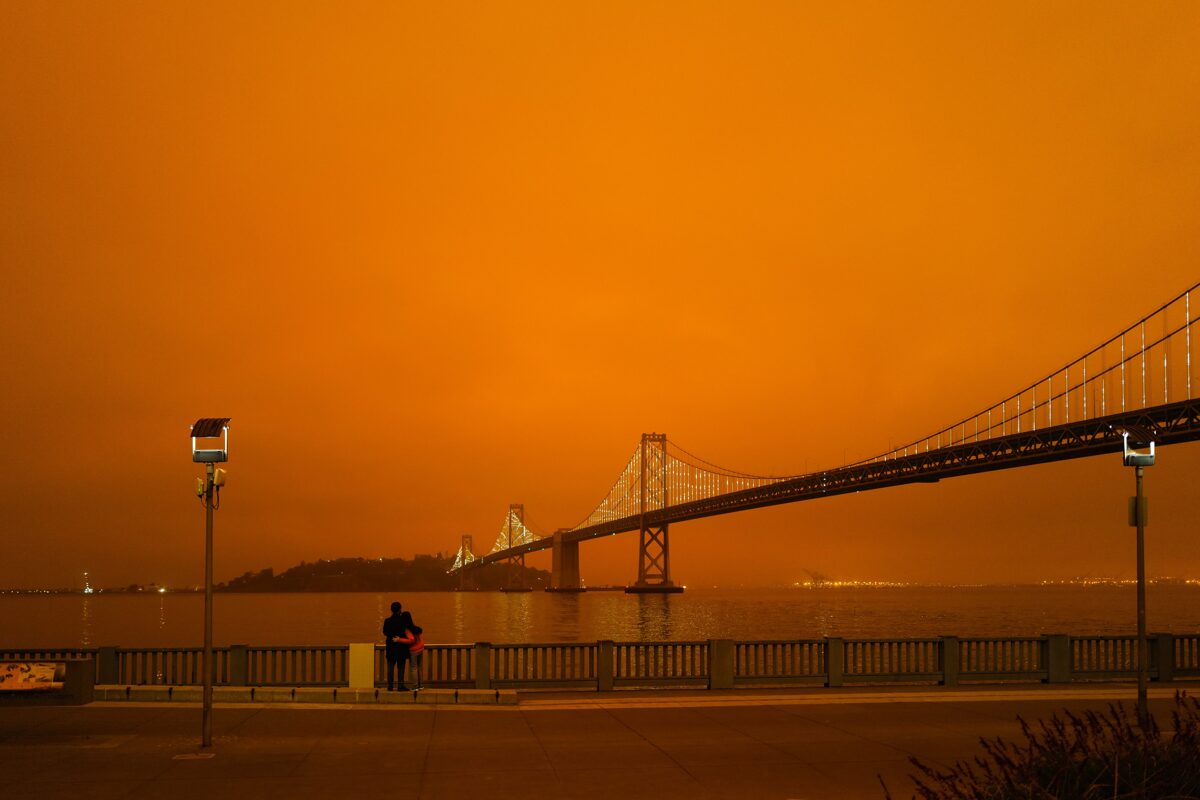
Photo by Thom Milkovic on Unsplash
Asbestos, a
hazardous material commonly found in buildings constructed before the 1980s,
poses a severe risk during natural disasters, particularly wildfires. When
these buildings are ripped, broken, burned, blown, or washed away, asbestos
fibers are released into the air, leading to serious health conditions years
later. Shockingly, 71% of Americans are unaware that natural disasters increasetheir risk of cancer. Therefore, it is crucial to prepare for asbestos exposure
prevention when planning for natural disasters and severe weather to avoid
future health issues.
According to the Congressional Research Service, there are an average of 67,000 wildfires each year, burning 7 million acres annually. In 2018 alone, wildfires destroyed nearly 9 million acres nationwide, leading to a significant risk of asbestos exposure for individuals living in cities and residential neighborhoods.
To stay safe during wildfires, it is essential to follow proper asbestos exposure prevention tips, including evacuating the area immediately if instructed to do so, wearing an N-100 or P-100 respirator, designating a closed room, using a portable air cleaner, and staying indoors if not ordered to evacuate.
Furthermore, when cleaning up after a wildfire or storm, it is crucial to take precautions as even a protective mask might not prevent asbestos exposure. Fibers could stick to clothes and expose individuals and their families, potentially leading to inhalation or ingestion of hazardous materials. Seeking help from a qualified asbestos abatement company is advisable if large quantities of asbestos materials were damaged during a fire.
In conclusion, understanding the risks associated with asbestos exposure during natural disasters, particularly wildfires, and taking the necessary precautions is vital for preserving long-term health. For more information on this topic, visit https://www.asbestos.com/asbestos/natural-disasters/.
Source: The Mesothelioma Center at
Asbestos.com, 2019
Wildfire danger awareness by ChatGPT

Photo by Possessed Photography on Unsplash
Wildfires have been a growing concern around the world, with the potential to cause significant damage to property, wildlife, and even human lives. The wildfire season has been getting longer and more severe due to climate change, with prolonged droughts and high temperatures contributing to the increase in the frequency and intensity of these fires.
Wildfires pose a significant danger to communities and ecosystems, and it is essential to understand the risks and take steps to prevent and prepare for them. Here are some key points to consider:
Causes of Wildfires:
Wildfires can be caused by natural or human-made factors, including lightning strikes, high temperatures, drought, and human activities such as campfires, cigarettes, and fireworks. It is crucial to be aware of the risks and take steps to minimize the potential for fires.
Impact of Wildfires:
Wildfires can have devastating effects on the environment, wildlife, and human communities. They can destroy entire forests, homes, and buildings, and have long-lasting effects on soil quality, water supply, and air quality. Smoke from wildfires can also cause health problems, particularly for those with respiratory issues.
Prevention of Wildfires:
Preventing wildfires is key to reducing the risks they pose. It is essential to follow fire safety guidelines, including extinguishing campfires and not discarding cigarettes or fireworks. Clearing away debris and dead vegetation can also help to reduce the fuel available for fires to spread.
Preparing for Wildfires:
Preparing for wildfires is also important. This includes creating a defensible space around homes, having an emergency plan in place, and being aware of evacuation routes. It is also crucial to have a survival kit on hand that includes essentials such as water, food, and first aid supplies.
Conclusion:
Wildfires are a significant danger that requires attention and action to prevent and prepare for. By being aware of the risks and taking steps to reduce them, we can help to protect our communities and ecosystems from the devastating effects of these fires. Stay informed and take action to minimize the risk of wildfires in your area.
Author: ChatGPT
Source: OpenAI
Wildfire Safety Guide
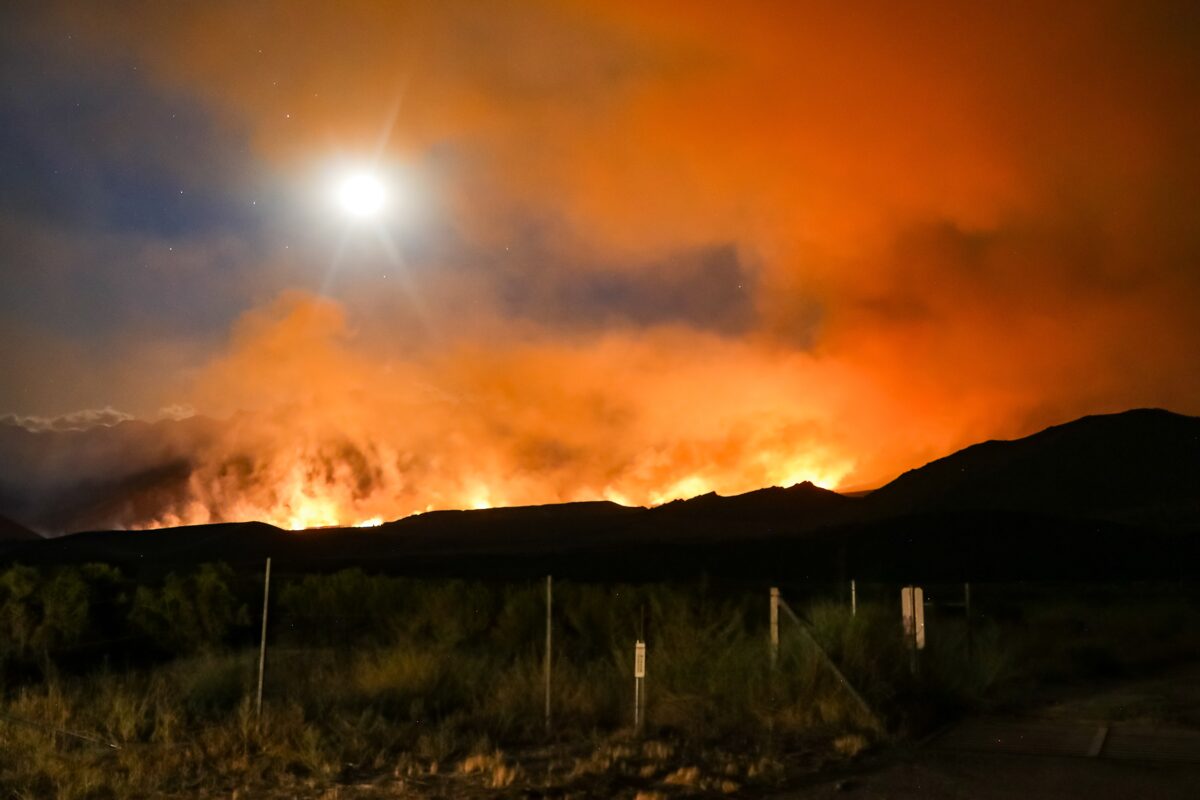
If you’re a homeowner, it can be highly stressful if a wildfire begins and spreads to your general location or residence. Learn everything you need to know about wildfires and how to stay safe.
There are specific actions you can take to aid in preventing wildfires. First, you can always be aware of how you’re managing campfire sites. It’s important to be a responsible campfire custodian to avoid any accidents.
Another type of burning to be mindful of is debris burning. Whenever you have brush piles to burn, you must do so responsibly, following all local ordinances.
Lastly, be aware of safety with equipment use. The type of equipment you choose and how you manage it can contribute to fire prevention and safety.
There are steps you can take to prepare for a wildfire:
- Gather supplies. You should assemble an emergency supply kit for each person;
- Sign Up for Alerts;
- Track Current Wildfires.
There are steps you can take to strengthen your home:
- Use fire-resistant materials for some parts of your home;
- Have access to a water source in case you need it;
- Consider shutters and fireproof drapes;
- Prevent embers from entering the home.
If you don’t strengthen the areas around your home, the damages and repercussions can be catastrophic. What can you do to prepare the area?
- Rake leaves;
- Trim 15ft of space between tree crowns;
- Properly store flammable materials and liquids;
- Keep your grass mowed.
Also you should always have evacuation plans and ensure that you, your children, your pets, and others know exactly what to do in advance in case of a wildfire.
If you happen to get caught in a wildfire, the first step is to look for a body of water, including a pond or river, to crouch in. If no water is nearby, find a depressed area that’s cleared and has no vegetation. You should lie low to the ground, cover your body with wet clothing, a blanket, or soil. Call firefighters.
For more information please visit https://cutterlaw.com/wildfire-safety-guide/
Wildfires burning Greece
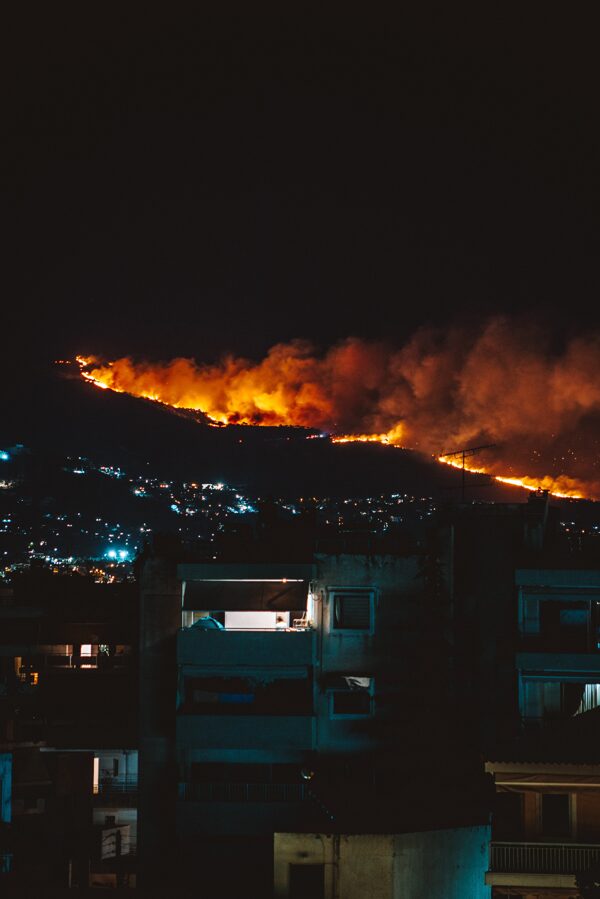
Photo by Anasmeister on Unsplash
This year has already been a damaging one for wildfires in Greece with the most recent example being the large blaze on Mount Penteli in Athens’ northern suburbs that ignited on July 19th.
In the first few months of 2022, thirty forest fires were recorded in the country, a massive increase from the usual four. Those fires burned over 1,000 hectares (2,471 acres) of land compared to the average 37.5 (around 92 acres). (1)
This year confirms the general trend of increased frequency and intensity of wildfires and heatwaves in the country, which is aggravated with effects of climate change. This comes after a very destructive previous year in 2021, where Greece experienced multiple wildfires in conjunction with a historic heatwave for the country (highest temperatures reaching 47.1 °C).
It is expected that 2022 will break new records, according to the National Observatory of Athens (NOA), as the European Forest Information System (EFFIS) has registered a 750% increase of blazes in just the first 3 months of compared to the period of 2008 to 2021. Although the causes of above-mentioned fires are currently under investigation, they are usually caused by a combination of different factors. Nonetheless, wildfires are often sparked by human activity, accidental or otherwise, which are exacerbated by climate conditions - a perfect storm of high heat, dry weather, high wind. (2)
The fires forced thousands of people to flee as forests, agricultural land, homes and businesses burned. Greece's fire protection capabilities have been stretched to the limit, and the government, which appealed for international help, faced strong critique for its response. Although the government has blamed the disaster on the heat wave, Citizens Protection Minister Michalis Chrisochoidis announced that a special prosecutor for organised crime cases was involved in a probe into the causes of the fires. (3)
Amplicam and its partner has launched a pilot detection system in Greece that will help identify wildfires and evaluate efficiency of the system in local conditions.
To learn more please contact us: info@amplicam.com and book a demo
Sources:
1) (https://greekreporter.com/2022/07/20/greece-wildfires-2022/)
3) https://www.dw.com/en/greece-wildfires-new-blaze-hits-evia-island/a-58954794
Points of Wildfire summit in San Francisco, California
International Association of Wildland Fire prescribes the following Calls for Action:.
Increase prescribed burning.
Identify ecosystems most at risk to large, high-severity wildfire.
Identify and enhance fire-adapted communities.
Foster safe and effective interagency wildfire response.
Promote shared responsibility for safer community preparedness, response, and recovery.
Reimagine and invest in the wildland fire management workforce and systems.
Invest in and promote research, science, technology, and policy.
Create opportunities for continuous improvement and adaptive management.
According to U.S. Department of Agriculture Forest Service for year 2022 there are the following Federal Firefighting Assets: 16,700 firefighters, 200+ helicopters, 35 single engine airtankers (SEATs), Up to 23 airtankers, 360 pieces of heavy equipment, 1,550+ engines.
For wildfire detection California is using technologies such as The SCOUT platform that provides an information sharing environment for small to extreme scale homeland security and emergency management incidents. SCOUT can facilitate strategic and tactical collaboration, training and technical management for and among the partnership. Another technology is Fire Integrated Real-Time Intelligence System. FIRIS is a state level mutual aid asset and is an All Hazards Intelligence Platform.
Colorado State is working on a new approach to early detection.
- Current Programs:
○ National Fireguard Program
○ DFPC Multi-Mission Aircraft (MMA)
○ Camera Pilot Program
For managing wildfires there are international initiatives organized - Bilateral Agreements/Arrangements, International Committees, International Study Tours, Ongoing support to Forest Service International Programs.
According to NASA, next generation fire prediction combines emerging fire science with data from many sources. For example ground-based real-time weather and camera imagery, information about fire perimeter, remote sensing, landscape data, weather forecast and modelling, land cover and fuel. There are some challenges that affect wildfire management:
Surveillance using infrequent, high spatial resolution satellite or aircraft observations.
Fire detection and location accuracy is not precise enough for effective targeting.
Few models for tracking and predicting fire progress, many are unreliable.
Better sensing is needed because it is difficult to observe through clouds and at night.
Data and model fusion is limited, need for an integrated observing system.
Overall, the evidence shows that climate change will bring more wildfires and they’re predicted to be more severe. Prevention and early detection combined with an educated emergency response is the only way to stop wildfires from further catastrophic destruction. The use of technology is imperative and the investment in this sector needs to be immediate.
Amplicam is here with proven solutions that we know will save lives and give the environment the only chance it has to survive climate change and the ensuing wildfires.
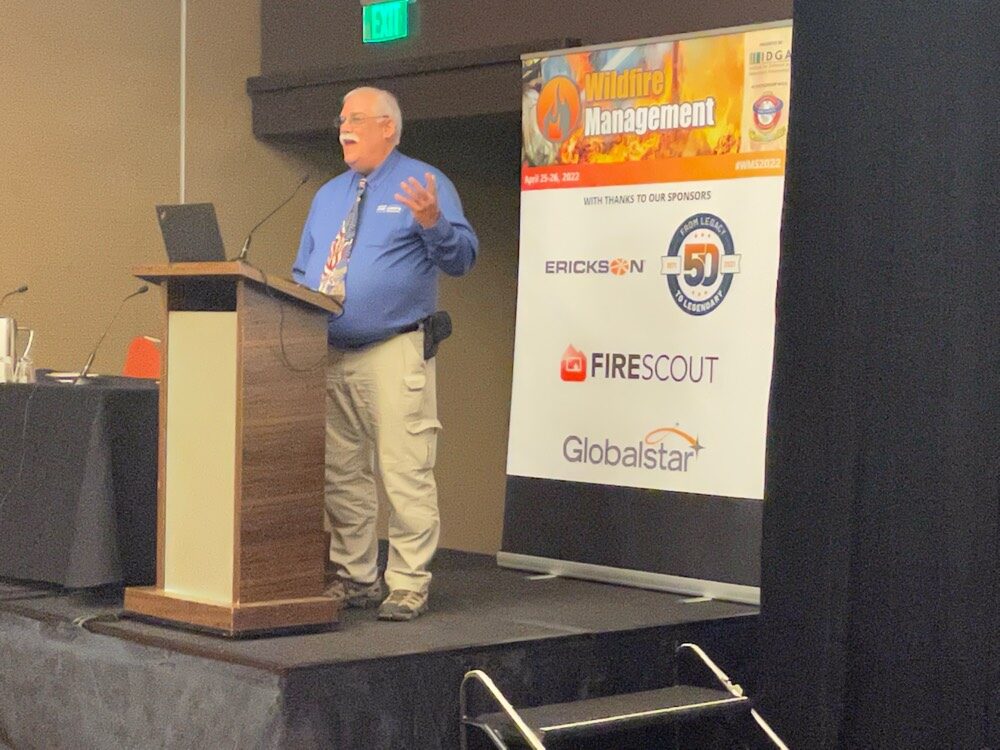
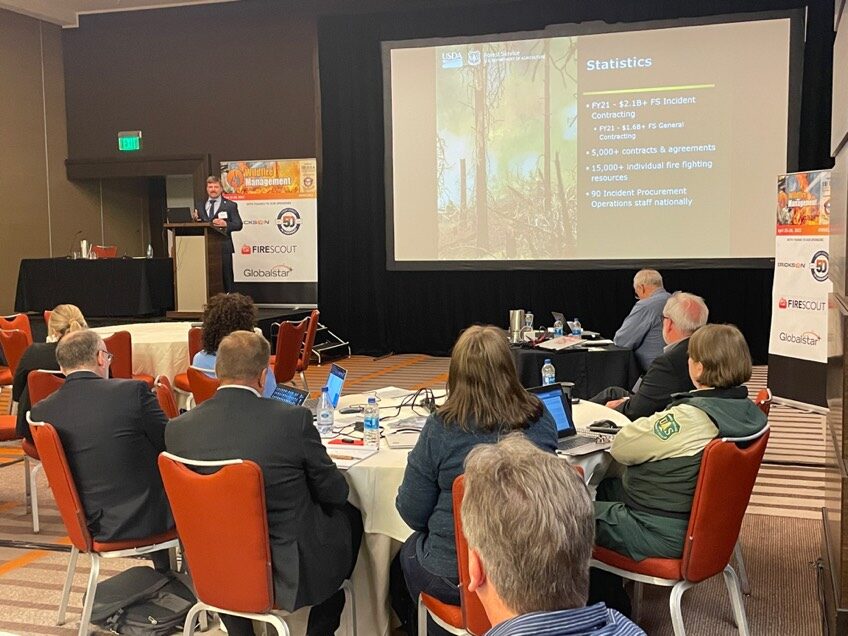
Amplicam visits Wildfire Summit in California
California has dry, windy, and often hot weather conditions from spring through late autumn that can produce moderate to severe wildfires. Protecting people, property, and resources from wildfires is an increasingly difficult challenge due to changing environmental conditions across the US and the world. However, an extremely unusual set of factors make doing the critical job of fighting wildfires in California even more difficult and complex. California is currently experiencing:
Pressure from a population of 38 million people
Fear of wildfire community destruction with over 2,000 communities identified as ‘at risk’
Increased urban and infrastructure development into California’s wilderness
Unusual, unpredictable and ever-changing weather conditions
Unprecedented tree mortality conditions with 129 million dead trees state-wide (2.)
During the 2020 wildfire season alone, over 8,100 fires contributed to the burning of nearly 4.5 million acres of land. As of April 2, 2022, a total of 925 fires have been recorded, totalling approximately 6,158 acres (2,492 ha) across the state with peak fire season not even expected until summer or fall. (3) The 2022 California wildfire season is of particular concern because it follows the 2020 and 2021 California wildfire seasons, which had the highest and second-highest (respectively) numbers of acres burned, on record. (1.)
United States taxpayers pay close to $3 Billion per year to fight wildfires, and big fires can lead to billions of dollars in property losses. More than 350,000 people in California live in towns situated completely within zones deemed to be at very high risk of fire. In total, more than 2.7 million people in California live in "very high fire hazard severity zones", which also include areas at lesser risk. (1)
Some in the firefighting sector say the tools and technologies used to combat new blazes have not kept up with the impact of climate change's fury. It is clear that new approaches and new technologies are needed. As governments put out the call for assistance, the private sector has stepped up to deliver advice, products and services that prevents, detects and mitigates wildfire damage.
As a member of this private sector contingent that offers wildfire detection and prevention solutions to communities and governments, Amplicam will be attending the Wildfire Management Summit on April 25-26, 2022 in San Francisco, California. Innovative strategies and emerging technologies to prevent wildfire damage are on the agenda, formally addressed by leading experts and will be discussed among attendees networking and peer learning.
On day 1 of the conference, the focus is on North America, and kicks-off with a USDA forest service outlook for 2022 delivered by Randy Moore, Chief, USDA Forest Service and Jerome E. Perez, National Director, Fire and Aviation Management, USDA Forest Service. There will also be a talk on how emergency services are coordinated during extreme fires in California by Brian Marshall, Chief, Fire and Rescue, California Office of Emergency Services (CAL OES)). Discussion of Colorado’s new approach to early detection and rapid initial attack along with Canada’s wildfire suppression and response in Canada, and approaches to forest fire management in Brazil, are all on the 1st day’s agenda.
The second day of the conference has a focus of international wildfire fighting cooperation and the latest research on the topic from across the world. Professionals from countries such as Germany, Spain, Portugal, Singapore will speak about their national experience fighting wildfires as well as international collaborative initiatives in wildfire management.
Incident management and operational awareness; Collection, storage and analysis of actionable and accessible data; Data from remote sensors, thermal cameras, drones, satellites and other technologies will all be a major focus on this second day of the conference as well as exploration into how NASA is working with government agencies, standards organisations and industry leaders across the world to make sure that the data is usable and actionable in operational wildfire situations.
We at Amplicam along with our international partners in wildfire prevention and detection look forward to attending the IDGA Wildfire education conference this month and invite similarly interested parties to get in touch before, during or after the event for more information.
Sources:
1) https://en.wikipedia.org/wiki/List_of_California_wildfires
2) https://www.nwcg.gov/publications/pms437/weather/fire-season-climatology#TOC-Northern-California
3) 2) https://www.blm.gov/programs/public-safety-and-fire/fire-and-aviation/regional-info/california
4) https://abcnews.go.com/Technology/worsening-california-blazes-prompt-calls-innovations-fight-fires/story?id=79871349
5) https://calmatters.org/commentary/2021/10/new-approaches-needed-to-fight-wildfires/
Amplicam goes to Brazil
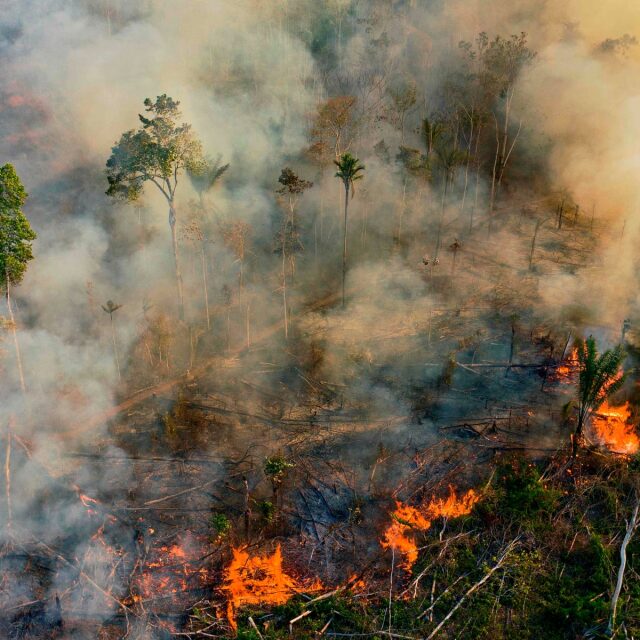
Karl de Sousa. AFP Getty Images.
Brazil has experienced unprecedented wildfires in the last decade. In 2019 and 2020, fires in different Brazilian biomes received much attention in the media and in the public debate, also internationally.
The number of forest fires in the Pantanal, the world's largest tropical wetlands, has tripled in 2020 compared to the year 2019, according to Brazil's national space agency Inpe. It identified 3,682 fires from 1 January to 23 July in the region, an increase of 201% compared to 2019. In the Pantanal, the wildfires in 2020 marked a sad record of burning the largest area registered over the past 20 years: almost 30% of the biome's area was on fire.
Scientists in Brazil concluded a particularly grim conservation study - attempting to count the animals killed by huge wildfires in the Pantanal wetlands. They estimate that as many as 17 million vertebrates - including reptiles, birds and primates - died.
Members of environmental network the Pantanal Observatory called the fires "a social danger since, in addition to the economic damage and the loss of biodiversity, fires cause respiratory problems, eye irritation and allergies," according to Brazilian newspaper O Globo.
The risk of severe fire events will likely increase in the future, as climate change effects become stronger and cause more extreme climatic events. Also, the majority of wildfires in Brazil are manmade - the result of illegal deforestation and clearing of farmland.
The actions taken in response to wildfires in Brazil by governmental agencies overall have been more reactive than preventive, and a huge policy gap to face the fire problem exists. Fire management thus must be developed in an integrated way with other policy fields, especially those related to land tenure and land management, and in accordance with the climate change agenda.
To effectively reduce fires and their negative effects, Brazil needs a long-term commitment with conservation and sustainable development that considers the distinct ecological, socio-economic and cultural realities across the country.
While the government of Brazil is working hard on limiting wildfires, Amplicam joins with its Wildfire early detection and monitoring software. Amplicam has signed partnership agreement with Brazilian company C & R Consultoria Empresarial Ltda (S+) aiming to help reduce damage caused by wildfires.
S+, a solutions` provider Brazilian based company started in 1998 as a representation company offering to the local market products and services without similar.
Since then, the operation of the company evolutes to a multi task service company and today we and associated partners offer: training, video production, distant learning, consultancy, BPMN, auditing, financial services, start-up projects, fund-raising, co-working, social media and website`s development, mentoring, counselling and much more services.
With on demand resources and experienced collaborators for any kind of business, we can offer solutions with commitment and precision.
Sources:
https://www.sciencedirect.com/science/article/pii/S2530064421000560
https://www.bbc.com/news/world-latin-america-53500288
https://www.wwf.org.uk/press-release/illegal-deforestation-report-brazil
2022 – the world's best last chance to limit wildfires
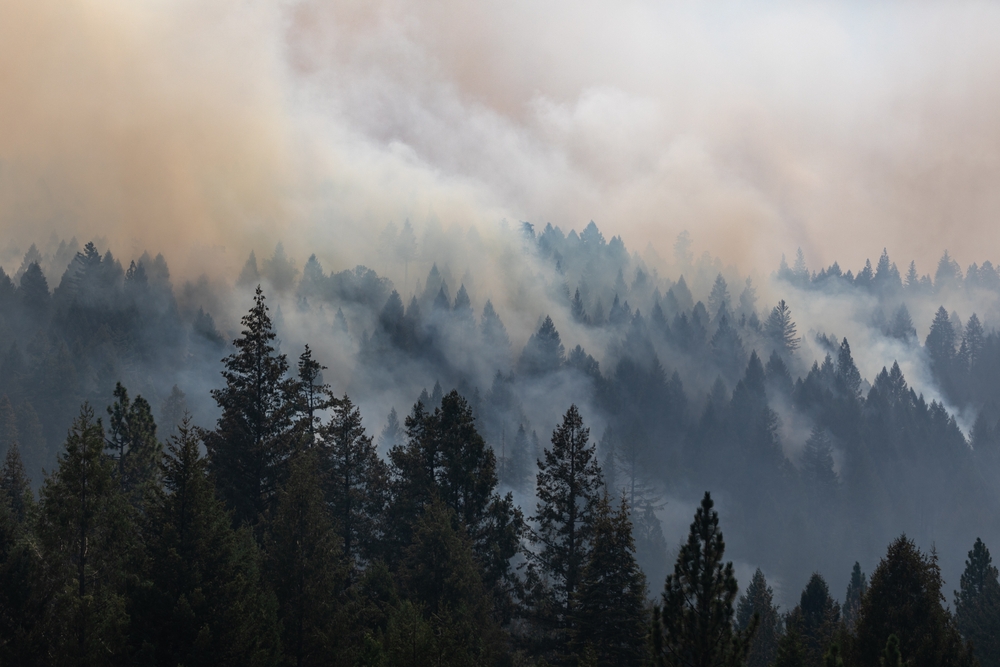
2021 will go down in history with COP26 - the annual summit organized by United Nations and often referred to be the world’s best last chance to get runaway climate change under control. We at Amplicam strongly believe that the year 2022 should be the world’s best last chance to limit wildfires by using modern technologies and significantly reducing CO₂.
Amplicam signs agreement with Investment and Development Agency of Latvia (LIAA)

Amplicam is launched in South Africa
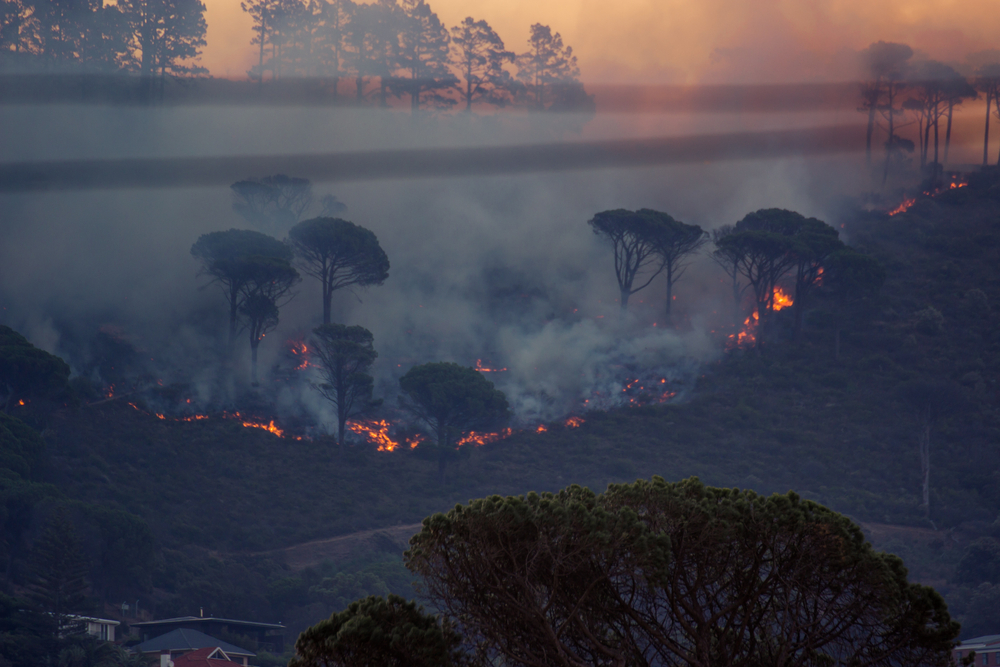
Amplicam’s wildfire detection, monitoring & control system has just been launched in South Africa. It helps to protect local farmers against vandalism and wildfires caused by riots.
How Wildfire Detection Software Helped to Avoid a Tragedy in Jaunciems
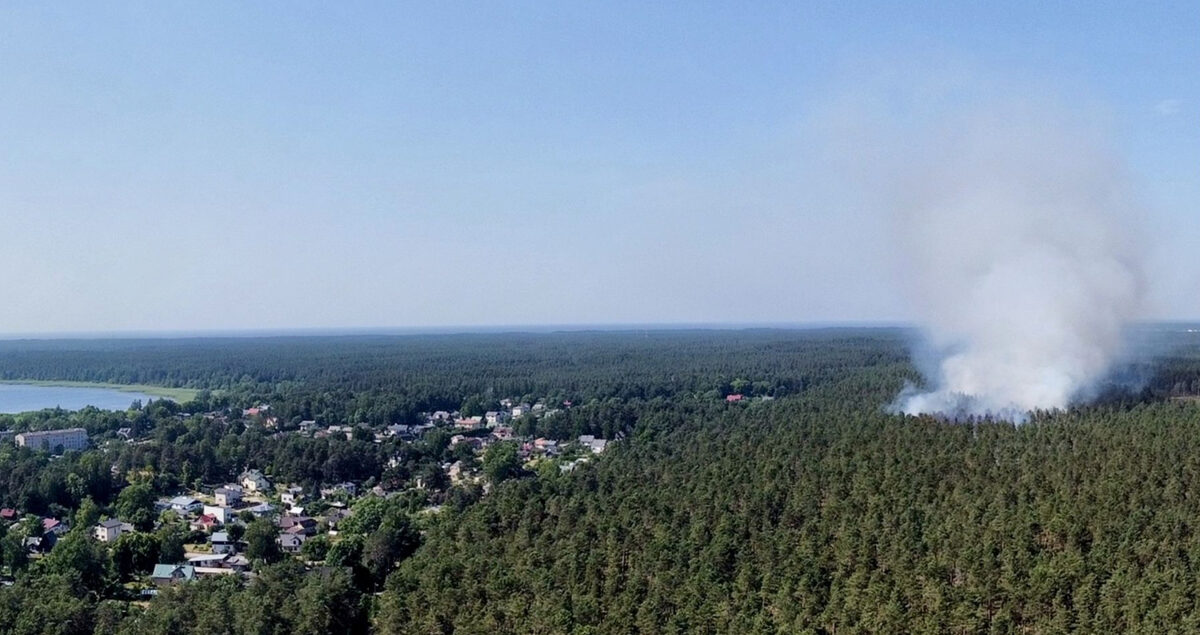
Photo: Emīls Gatis Liepiņš
It was
just one step from a tragedy in Jaunciems – a territory located
near Latvia’s capital city Riga. During one of the hottest summers
ever recorded in the country, a wildfire started in the forest at
Jaunciems just 300m away from houses. Most likely it started in
several places simultaneously.
Fighting wildfires – a technological perspective
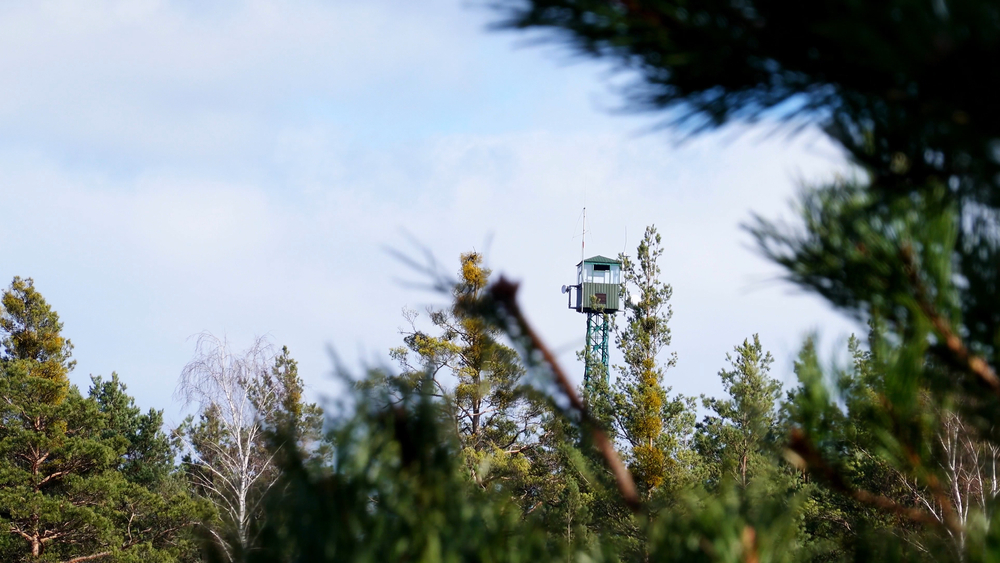
The number of wildfires is increasing all over the planet each year. There is no single understanding, principles, or guidelines on how to prevent them. Everything depends on the willingness of owners of forests to take care of their territories as well as on society’s level of education on how to behave inside and around forests. Given the overall development of technology, different advanced technologies able to detect and prevent wildfires are becoming more accessible. However people in the industry are not that keen on using them yet, so let's explore methods that currently are available for fighting wildfires.
Why planet Earth is burning?
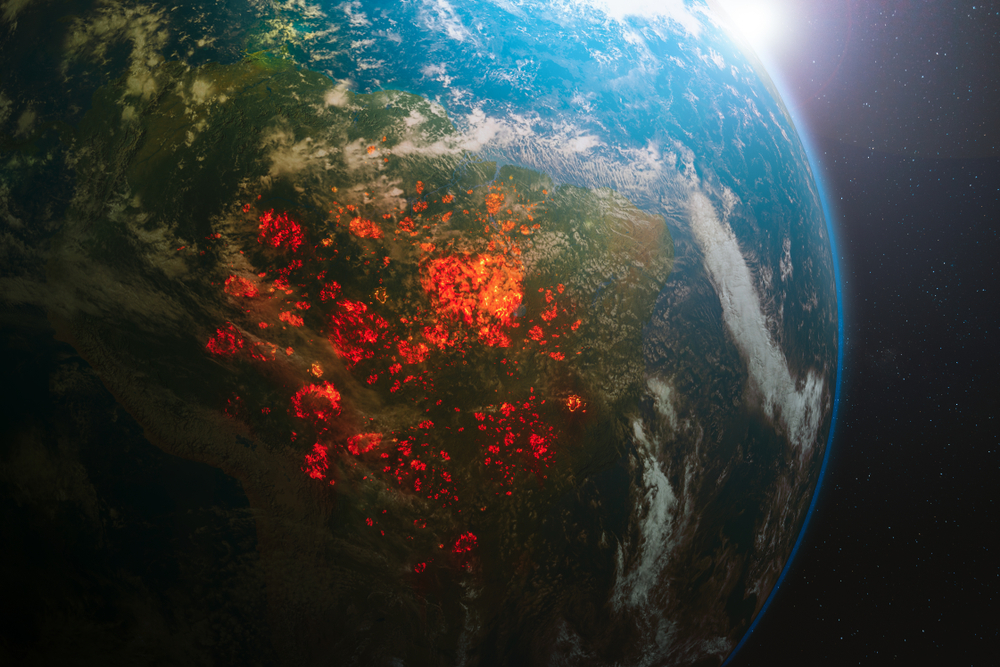
2018 was the deadliest and the most destructive wildfire season in California with 102 fatalities and costing over USD 3.5 billion. Around this time a lot of wildfires also occurred in other parts of the world. For example, in Greece in 2018 about 102 people lost their lives in a wildfire. In Portugal in 2017 wildfires took 66 lives. And it didn’t stop there.
Proud member of Canadian Chamber of Commerce
Amplicam, pursuing it's expansion goals in export markets,
has joined Canadian Chamber of Commerce in Latvia. Andris Luriņš, CEO Amplicam:
Amplicam, as a provider of
early stage automated fire detection systems, video surveillance &
geographic information, and fire-fighting resource control and reporting
systems, is thrilled to be part of such a vibrant and active business community
as the Canadian Chamber of Commerce in Latvia. We appreciate the Chamber’s real
and tangible engagement in helping Amplicam to succeed in Canada.
Ed Kalvins, President and Chaiman of Canadian Chamber of
Commerce welcomed the new member:
"Latvia generates extremely useful innovations. The Canadian Chamber of Commerce in Latvia promotes the development of partnerships between Canadian and Latvian entrepreneurs, and are please to support the introduction of Amplicam expertise to Canada and the world in an effort to minimize the effects of devastating wildfires as our contribution to our climate and to the well-being of humanity. We welcome innovative entrepreneurs such as Amplicam to our membership ranks."
For more inquiries: info(at)amplicam.com
